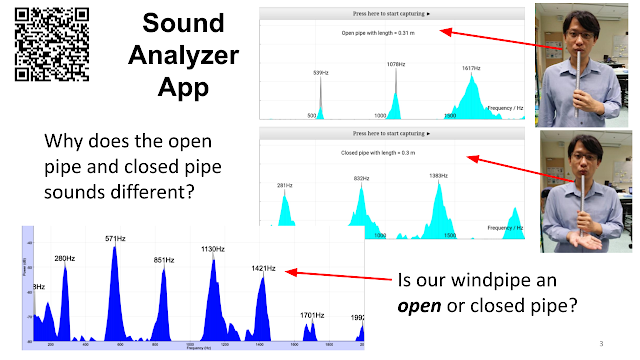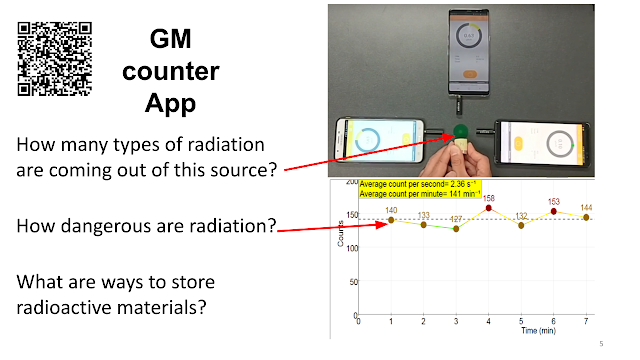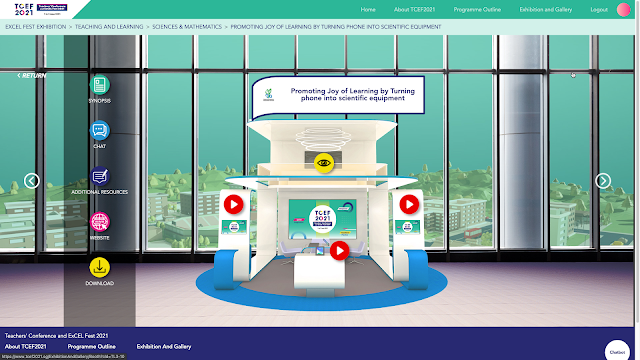TCEF2021: Teachers' Conference and ExCEL Fest 2021 CPDD-ETD Promoting Joy of Learning by Turning phone into scientific equipment
1 to 3 June 2021
thanks to Tze Kwang and Fang Fang
Briefly describe what the featured project is about
(in no more than 200 words)
There is a lack of turning smartphones into scientific data-loggers for students to interact with and learn from for some topics, especially light, sound and modern physics. Teachers usually explain the phenomenon in words and equations and students have to imagine the phenomenon and appreciate physics that describe the real world. Therefore, students will typically find it hard to visualize and understand these concepts.
In this project, we turn the students’ smartphone into scientific data-loggers that enable them to use their smartphones to collect data and become scientists investigating the world around them, making physics relevant and real world, by using their smartphones’ built-in sensors. We designed user-friendly phone web browser apps with suggested experiments that allow students to use their smartphone sensors and additional fixtures to collect measurements and learn science anytime and anywhere.
Three smartphone physics experiments were developed:
Light analyser to study the spectrum of different light sources by attaching a 3D printed spectrometer to their phone.
Sound analyser to study the sound spectrum of different sounds produced. The app is able to predict the length of pipes and whether it’s open or closed.
Radiation analyser to study the radiation of different radioactive sources. We have worked with NEA to purchase a low dosage radioactive source for schools to study the phenomenon.
Word Count: ____192_________
Key benefits to teachers / students / staff*
(in no more than 300 words)
The three experiments we have carefully chosen are currently not done in most schools and would provide a novel learning experience for students. Instead of using expensive and complex equipment in the laboratory, these experiments can be done conveniently with a smartphone which most students are equipped with, hence saving cost.
Since smartphones have built-in sensors and when using our mobile web browsers, students can collect real time data rapidly and display these data in multiple representations that help to deepen students' understanding. With smartphones serving as data-loggers, every student can collect data and be actively engaged in science inquiry, leading to better student outcomes. The ability to collect and process data rapidly gives students more time to identify questions and concepts, design and conduct experiments and construct explanations and models. They act like scientists by investigating the world around them, making physics relevant and real world.
The convenience of using a smartphone to do experiments also allows the students to continue to explore the phenomenon beyond the laboratory sessions and the physical laboratory. The experiments can be conducted at home, after school, anytime, anywhere for more practice, or an expanded scope of inquiry- one smartphone, many experiments.
The experiments were trailed with teachers from YIJC, NJC and JPJC. The feedback was positive, and the teachers gave inputs to improve the experiments which have already been implemented. With confidence from the feedback, we conducted a workshop for teachers from all pre-university to transfer the learning from this project.
We have also created SLS lessons based on these experiments for teachers to use. In addition, the experiments have been converted into android and iOS apps so that they can be run offline.
The web app resources can be found here https://iwant2study.org/ospsg/index.php/576
Word Count: _____277________
(in no more than 200 words)
There is a lack of turning smartphones into scientific data-loggers for students to interact with and learn from for some topics, especially light, sound and modern physics. Teachers usually explain the phenomenon in words and equations and students have to imagine the phenomenon and appreciate physics that describe the real world. Therefore, students will typically find it hard to visualize and understand these concepts.
In this project, we turn the students’ smartphone into scientific data-loggers that enable them to use their smartphones to collect data and become scientists investigating the world around them, making physics relevant and real world, by using their smartphones’ built-in sensors. We designed user-friendly phone web browser apps with suggested experiments that allow students to use their smartphone sensors and additional fixtures to collect measurements and learn science anytime and anywhere.
Three smartphone physics experiments were developed:
Light analyser to study the spectrum of different light sources by attaching a 3D printed spectrometer to their phone.
Sound analyser to study the sound spectrum of different sounds produced. The app is able to predict the length of pipes and whether it’s open or closed.
Radiation analyser to study the radiation of different radioactive sources. We have worked with NEA to purchase a low dosage radioactive source for schools to study the phenomenon.
Word Count: ____192_________
Key benefits to teachers / students / staff*
(in no more than 300 words)
The three experiments we have carefully chosen are currently not done in most schools and would provide a novel learning experience for students. Instead of using expensive and complex equipment in the laboratory, these experiments can be done conveniently with a smartphone which most students are equipped with, hence saving cost.
Since smartphones have built-in sensors and when using our mobile web browsers, students can collect real time data rapidly and display these data in multiple representations that help to deepen students' understanding. With smartphones serving as data-loggers, every student can collect data and be actively engaged in science inquiry, leading to better student outcomes. The ability to collect and process data rapidly gives students more time to identify questions and concepts, design and conduct experiments and construct explanations and models. They act like scientists by investigating the world around them, making physics relevant and real world.
The convenience of using a smartphone to do experiments also allows the students to continue to explore the phenomenon beyond the laboratory sessions and the physical laboratory. The experiments can be conducted at home, after school, anytime, anywhere for more practice, or an expanded scope of inquiry- one smartphone, many experiments.
The experiments were trailed with teachers from YIJC, NJC and JPJC. The feedback was positive, and the teachers gave inputs to improve the experiments which have already been implemented. With confidence from the feedback, we conducted a workshop for teachers from all pre-university to transfer the learning from this project.
We have also created SLS lessons based on these experiments for teachers to use. In addition, the experiments have been converted into android and iOS apps so that they can be run offline.
The web app resources can be found here https://iwant2study.org/ospsg/index.php/576
Word Count: _____277________
Video
YouTube video links to the 3 smartphone experiments
1) Sound Analyser:
https://www.youtube.com/watch?v=2u_djWwm0u8&t=1s
2) Light Analyser:
https://www.youtube.com/watch?v=XQiUvY94uMc
3) GM Counter:
https://www.youtube.com/watch?v=ypMTHXsLHrg

